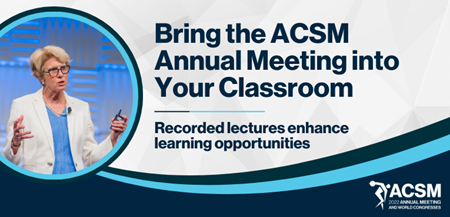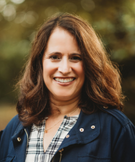Kimberly Reich, Ph.D., ACSM-EP |
Jan.
10, 2023
Recorded lectures enhance learning opportunities
 As educators, we endeavor to facilitate meaningful classroom learning experiences. A perennial topic of discussion among educators within ACSM is this: How can we engage our students in ways that will drive connection, deepen their knowledge and align with the things that matter to them? Incorporating scientific and professional development content from the ACSM Annual Meeting into classroom instruction is a way to start, and an accessible way to do this is by mindfully embedding conference session recordings into course activities.
As educators, we endeavor to facilitate meaningful classroom learning experiences. A perennial topic of discussion among educators within ACSM is this: How can we engage our students in ways that will drive connection, deepen their knowledge and align with the things that matter to them? Incorporating scientific and professional development content from the ACSM Annual Meeting into classroom instruction is a way to start, and an accessible way to do this is by mindfully embedding conference session recordings into course activities.
How did I arrive at this opinion?
In 2011, I brought the first of many groups of undergraduate students to the ACSM annual meeting. They were not college seniors traveling to present research as a culminating experience in their undergraduate career. Instead, they were second year students taking their first exercise physiology course during an accelerated “maymester” academic term. As part of the course, they attended conference sessions and then processed their experience in assignments aimed to help them integrate new information into their understanding and perspectives on course concepts.
In response to their experience at the annual meeting, students expressed increased motivation to learn, confidence in their growing expertise, interest in conducting research and commitment to pursuing careers related to exercise and sports sciences. Yes, the experience of being at a professional meeting among scholars and practitioners was impactful, but they also pointed to the “a-ha” moments they experienced when attending conference sessions as particularly influential.
Obviously there was no way to scale this experience beyond one small group of students every May. If only I could bring a little of that “a-ha” magic to all of students during the academic year. I discovered that ACSM had a YouTube channel where presentations from the annual meeting, health & fitness summit, and other ACSM meetings were posted—a small goldmine of presentations by preeminent, engaging scholars. I curated a collection to incorporate into one of my courses for required viewing, and titled it the “Keynote Lecture Series” in the syllabus. The response from students was beyond my expectations.
What are some ways you can bring ACSM conference “magic” to your course(s)?
The resources available to ACSM members has expanded tremendously. There is now a platform on the ACSM website where we can access keynote, named lecture, clinical track and nutritional track sessions.
There are so many ways you can use these recordings to enhance the educational experiences of your students. First, choose a conference presentation that relates to an important course concept and watch the presentation together or assign viewing outside of class, and then use the viewing as a jumping off point for discussion or course assignments.
Here are a few ideas you can use to leverage the experience of watching a 2021 or 2022 ACSM conference recording:
- Take a “What, So What, Now What?” approach. Instruct students to take notes during their viewing on the below topics, and following their viewing discuss their responses to these questions in class or in a reflective writing assignment.
- What are the key points of the lecture and how do they connect to what they’ve been learning in the course?
- So what? Does the session expand their existing knowledge? Challenge conventional thought? Redefine their understanding? If so, how?
- Now what? Is there a real-world application of these findings? What new directions could they propose for research in this topic?
- Prompt students to search for the scholarly publications cited in the presentation and choose one or a handful for presentation or discussion in class. This is a great idea for group presentations or journal club-style discussions that students can lead. You could even use this as a jumping off point to assign a narrative review or annotated bibliography.
- Prompt students to find press coverage of findings presented in the conference session. Lead learning activities to evaluate the press coverage for accuracy and bias. You could even assign students to write their own news article about an aspect of the research presented.
- If recommendations are made within the conference session, assign students to create social media posts communicating those recommendations to the audience for whom they are intended, such as the general public or clinicians (e.g., Twitter, Instagram, TikTok, Facebook).
Have these ideas started the gears turning in your own head? The possibilities are endless!
Keynotes and featured lectures from the 2022 and 2021 ACSM Annual Meetings are available for ACSM members at no additional cost. They are available to nonmembers for a fee. CECs are available with the 2022 Annual Meeting content and additional recorded content from the 2021 Annual Meeting are both available at a member and nonmember rate.
ACSM's 2022 Annual Meeting Keynotes and Featured Lectures (FREE for ACSM members, $200 for nonmembers)
ACSM’s 2022 Annual Meeting Keynotes and Featured Lectures | 12 CEC-version ($150 for ACSM members, $300 for nonmembers)
ACSM’s 2021 Annual Meeting: Keynotes and President’s Lectures (FREE for ACSM members, $150 for nonmembers)
ACSM’s 2021 Annual Meeting: Clinical Sessions ($75 for ACSM members, $150 nonmembers)
ACSM’s 2021 Annual Meeting: Nutrition Sessions ($75 for ACSM members, $150 nonmembers)
 Kimberly Reich, Ph.D., ACSM-EP, is an associate professor in the department of exercise science at High Point University in High Point, NC where she is the supervisor for HPU’s Exercise is Medicine on Campus Leadership Team. Dr. Reich’s research focuses primarily on health behavior in individuals and communities. Her work explores resources designed to aid in the adoption and maintenance of physical activity and healthy eating. She is a former chair of the ACSM Exercise Science Education Special Interest Group, former SEACSM executive committee member, and currently serves on the ACSM Annual Meeting program committee.
Kimberly Reich, Ph.D., ACSM-EP, is an associate professor in the department of exercise science at High Point University in High Point, NC where she is the supervisor for HPU’s Exercise is Medicine on Campus Leadership Team. Dr. Reich’s research focuses primarily on health behavior in individuals and communities. Her work explores resources designed to aid in the adoption and maintenance of physical activity and healthy eating. She is a former chair of the ACSM Exercise Science Education Special Interest Group, former SEACSM executive committee member, and currently serves on the ACSM Annual Meeting program committee.